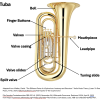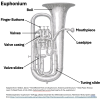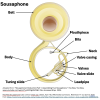return to: Music and Medicine on Monday (M+M+M) at the University of Iowa - Schedule of Events and Disclaimer
Content compiled by Evgeniya Molotkova, BS (4/2/2025)
How a Tuba Works (2:21 minutes)
Full Video with Performance
Definitions
Musical instruments may be divided into three major classes – wind, percussion, and string (Encyclopedia Brittanica, 2025).
- A wind instrument produces sound when air is forced into a resonant tube and vibrates (Encyclopedia Britannica, 2025).
- Percussion instruments vibrate to produce sound, usually from an outside physical force. They can be separated into two groups
- Idiophones – the instrument itself vibrates to produce sound (i.e. a bell)
- Membranophones – a stretched membrane that is part of the instrument vibrates (i.e. a drum)
- A string instrument produces sound when its stretched strings vibrate (Encyclopedia Birttanica, 2025)
Euphonium and tuba have common musical ancestors and are considered to be a part of the "tuba family" of brass wind instruments. These instruments differ in the following respects (Steen, 2024)
- The tuba is larger than the euphonium (has nearly double the amount of tubing) and creates a sound that is an octave lower
- The tuba is a bass-voiced instrument, and the euphonium is a tenor-voiced instrument
- The tuba has a larger mouthpiece requiring a very loose embouchure, or mouth positioning (James 2023)
Instrument Structure
Both the euphonium and tuba look outwardly similar. The euphonium and tuba, like all wind instruments, produce sound when air is blown into the mouthpiece. Since both are brass instruments, valves or slides operated by the musician can be used to change the pitch of the sound (Wikipedia contributors, 2025). Different combinations of key motions are used to produce notes. Both instruments have similar components.

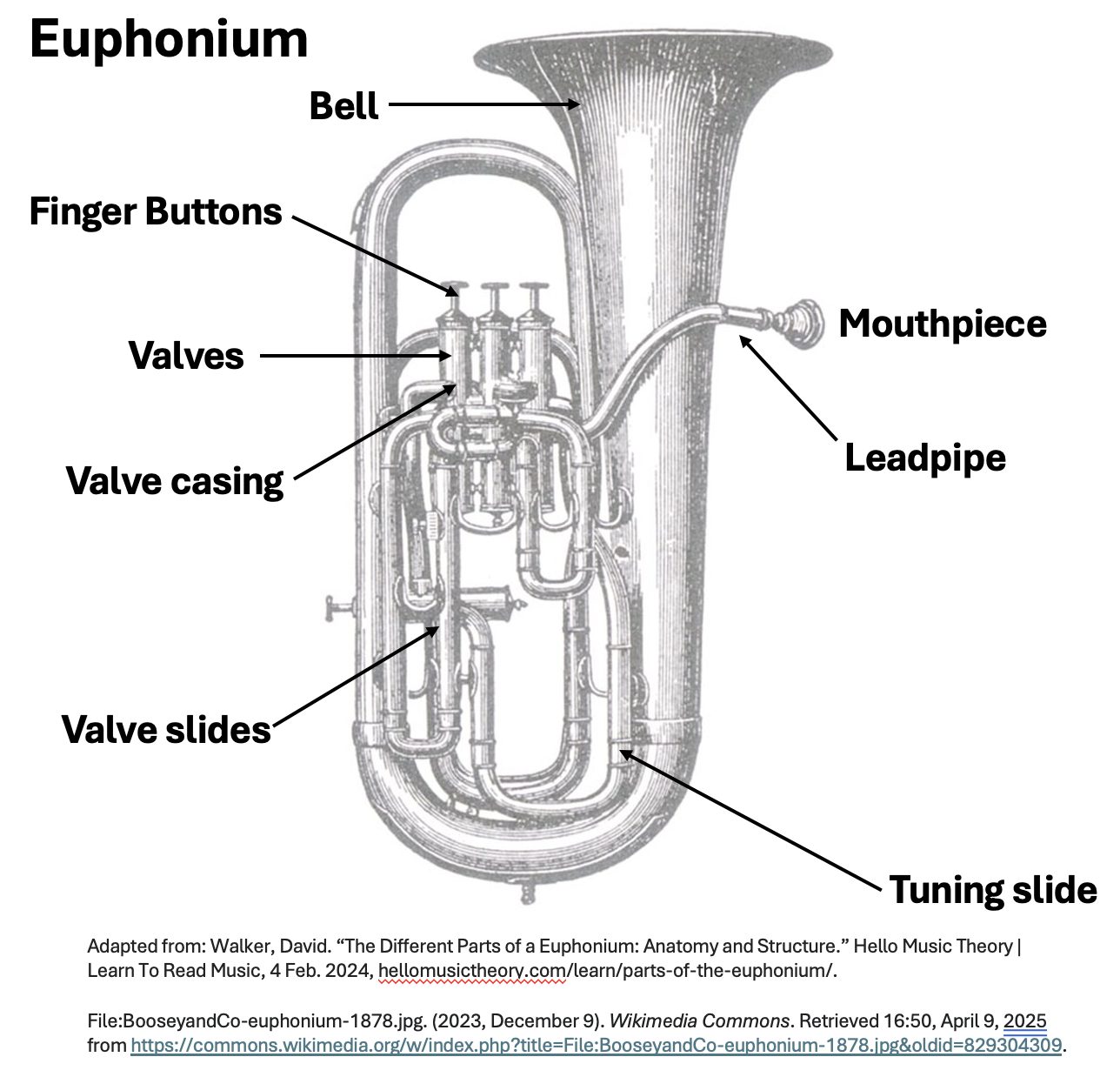
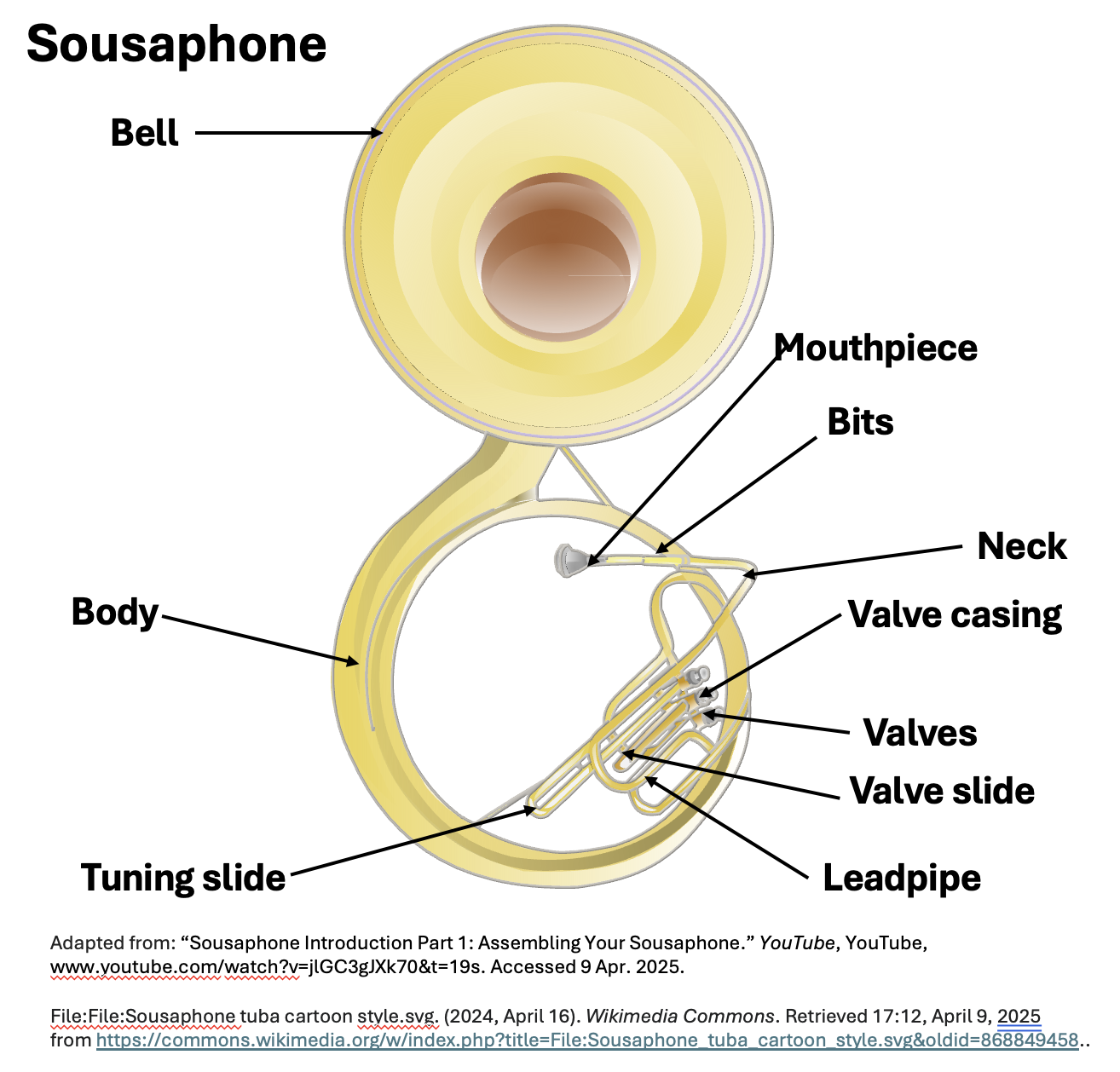
Individual components include (Walker, 2024):
- Mouthpiece: where the musician’s embouchure interfaces with the instrument itself.
- Modifying the embouchure alone can change tone, pitch, and volume produced. The mouthpiece can be removed for easier transportation and switched out to influence the sound of the music.
- Leadpipe: this component of the instrument serves as a connection between the mouthpiece and the instrument itself. Its component material may have some effect on the quality of the sound produced.
- Valves: structures that change the pitch of the sound produced. “Divert to different lengths of channel”
- Valve casings: contain the valves proper. They make sure that the sound is properly conducted. If a casing has a leak, exposing a valve, then little to no sound would be produced.
- Valve slides: structures that are connected to the valves. Moving a valve slide will change the pitch of the sound produced
- Spit valve: a small opening that is opened to release any condensation that has gathered inside the instrument
- Finger buttons: the musician presses different combinations of buttons to produce notes
- Tuning slide: can be adjusted to change the pitch of the instrument. Used instead of adjusting valves when the entire instrument is out of tune
- Bell: point of the instrument where the sound exits
History
Prior to the widespread adoption of the tuba, there were several predecessor instruments that were created to play lower registers in an orchestra. The earliest predecessor instrument, the serpent, was invented in 1590. It is a long, central tube that is bent into a snake-like shape. To change tones, the serpent had 6 tone holes positioned in 3 divisions of two. Covering all of the tone holes would produce a C below the bass clef (Schmidt, 1999). The more contemporary predecessor to the tuba, the ophicleide, was developed in 1821. The instrument looked/sounded similar to a baritone saxophone and was in widespread use before the tuba (Yeo et al, 1998).
The invention of the modern valve apparatus in the 1820s led to the independent development of many brass instruments. Valves made it possible to play even lower in the harmonic series. The military band master, Wilhelm Wieprecht, is credited with inventing the first tuba in 1835 along with instrument maker Johann Moritz. This instrument, called the basstuba, is considered a predecessor to the modern tuba (Yamaha, 2025). Three years after the invention of the basstuba, Mortiz introduced the tenor tuba, an instrument with a similar construction to the basstuba, but designed to play at a slightly higher range. Taking inspiration from the tenor tuba, Ferdinand Sommer created an instrument with thicker, more tapered tubes and called it the euphonium (Yamaha, 2025).
While Sommer was refining the euphonium, Adolphe Sax, the inventor of the saxophone, was working on a variety of saxhorns that played at different tonal ranges and included the alto, tenor, baritone, and bass saxhorns. Coincidentally, the bass saxhorn was sold under the name of “euphonium” for some time. The baritone saxhorn was the predecessor for the modern baritone. This overlap in history, as well as the appearance of the two instruments, may be a contributor to some of the confusion between a baritone horn and euphonium (Yamaha, 2025).
The sousaphone was developed in 1893 by J.W. Pepper in collaboration with John Philip Sousa, the instrument's namesake. The instrument was designed to produce sound similar to that of the tuba, but to be easier to hold and carry while standing or marching. The large circular loop of the instrument is meant to fit around the body of the musician (Wikipedia contributors, 2025).
Composition and Role in an Orchestra
Both the tuba and euphonium play parts in the lower tonal ranges in an orchestra. Since its inception, the euphonium has been an important part of British brass bands (Yamaha, 2025). While historically, both of these instruments have only been used in group settings, contemporary composers have created more solo compositions for both the euphonium and tuba.
References
“Classification of Instruments.” Encyclopædia Britannica, Encyclopædia Britannica, inc., 17 Mar. 2025, www.britannica.com/art/musical-instrument/Classification-of-instruments.
“Wind Instrument.” Encyclopædia Britannica, Encyclopædia Britannica, inc., www.britannica.com/art/wind-instrument. Accessed 2 Apr. 2025.
“Percussion Instrument.” Encyclopædia Britannica, Encyclopædia Britannica, inc., 21 Mar. 2025, www.britannica.com/art/percussion-instrument.
“Stringed Instrument.” Encyclopædia Britannica, Encyclopædia Britannica, inc., www.britannica.com/art/stringed-instrument. Accessed 9 Apr. 2025.
Steen A and Lux M: Euphonium vs. Tuba- The Difference Explained! Prime sound updated July 25, 2024 < https://primesound.org/euphonium-vs-tuba/ accessed 9-15-2024>.
James M: Euphonium Vs tuba, What Is the Difference? Music Industry How To updated Dec 28,2023 <https://www.musicindustryhowto.com/euphonium-vs-tuba-difference/ accessd 9-15-2024>
Wikipedia contributors. (2025, March 26). Brass instrument. In Wikipedia, The Free Encyclopedia. Retrieved 17:08, April 1, 2025, from https://en.wikipedia.org/w/index.php?title=Brass_instrument&oldid=128250...
Walker, David. “The Different Parts of a Euphonium: Anatomy and Structure.” Hello Music Theory | Learn To Read Music, 4 Feb. 2024, hellomusictheory.com/learn/parts-of-the-euphonium/.
“The Origins of the Tuba the Birth of the Tuba.” The Origins of the Tuba:The Birth of the Tuba - Musical Instrument Guide - Yamaha Corporation, www.yamaha.com/en/musical_instrument_guide/tuba/structure/. Accessed 1 Apr. 2025.
“The Origins of the Tuba Twists and Turns in the Development of the Tuba.” The Origins of the Tuba:Twists and Turns in the Development of the Tuba - Musical Instrument Guide - Yamaha Corporation, www.yamaha.com/en/musical_instrument_guide/tuba/structure/structure002.html. Accessed 1 Apr. 2025.
Paul Schmidt, "History of the Serpent, Part 1, Why a Serpent?," December 1, 1999, accessed September 30, 2014, http://www.serpentwebsite.com/hist1.htm.
Douglas Yeo, "TEMPTED BY A SERPENT," April 17, 1998, accessed September 30, 2014, http://www.yeodoug.com/articles/serpent/serpent_tempted.html.
Wikipedia contributors. (2025, January 8). Sousaphone. In Wikipedia, The Free Encyclopedia. Retrieved 16:40, April 9, 2025, from https://en.wikipedia.org/w/index.php?title=Sousaphone&oldid=1268266212
